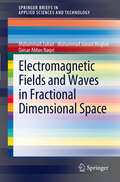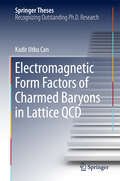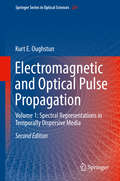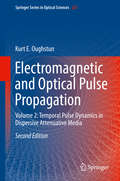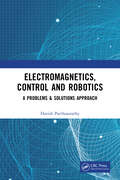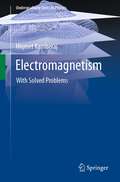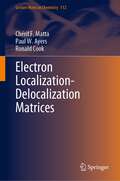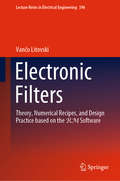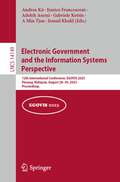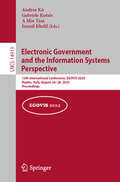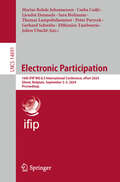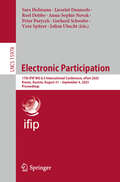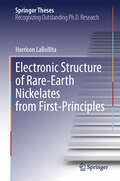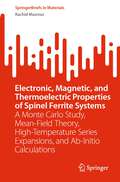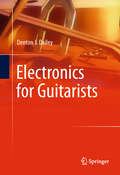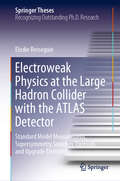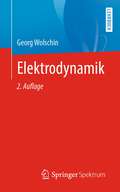- Table View
- List View
Electromagnetic Fields and Waves in Fractional Dimensional Space
by Muhammad Zubair Qaisar Abbas Naqvi Muhammad Junaid MughalThis book presents the concept of fractional dimensional space applied to the use of electromagnetic fields and waves. It provides demonstrates the advantages in studying the behavior of electromagnetic fields and waves in fractal media. The book presents novel fractional space generalization of the differential electromagnetic equations is provided as well as a new form of vector differential operators is formulated in fractional space. Using these modified vector differential operators, the classical Maxwell's electromagnetic equations are worked out. The Laplace's, Poisson's and Helmholtz's equations in fractional space are derived by using modified vector differential operators.
Electromagnetic Form Factors of Charmed Baryons in Lattice QCD (Springer Theses)
by Kadir Utku CanThis thesis presents the first lattice quantum chromodynamics (QCD) approach to the charmed baryon regime, building on the knowledge and experience gained with former lattice QCD applications to nucleon structure. The thesis provides valuable insights into the dynamics of yet unobserved charmed baryon systems. Most notably, it confirms that the expectations of model or effective field theoretical calculations of heavy-hadron systems hold qualitatively, while also demonstrating that they conflict with the quantitative results, pointing to a tension between these complementary approaches. Further, the book presents a cutting-edge approach to understanding the structure and dynamics of hadrons made of quarks and gluons using QCD, and successfully extends the approach to charmed hadrons. In particular, the thesis investigate a peculiar property of charmed hadrons whose dynamics, i.e., structure, deviates from their counterparts, e.g., those of protons and neutrons, by employing the lattice QCD approach —a state-of-the-art numerical method and the powerful ab initio, non-perturbative method.
Electromagnetic Sources and Electromagnetic Fields (Modern Antenna)
by Gaobiao XiaoThis book presents a modified spherical harmonic expansion method in which the electromagnetic fields and their sources are expanded with the same set of spherical vector basis functions in a similar procedure. Explicit expressions for the electromagnetic fields, potentials, energies, and the related Green’s functions are derived for the spherical modes in both frequency domain and time domain. Based on the formulation, the relationships between the electromagnetic sources, the electromagnetic far fields, and the electromagnetic near fields are clearly revealed. In particular, a nonuniform transmission line model is developed for intuitively characterizing the total radiation process. The introduction of the cutoff radius and the cutoff mode degree provides a simple reference for determining the numbers of degrees of freedom of the fields associated with sources in a bounded region. Based on the theory, an efficient hybrid method for synthesizing antenna arrays with complex footprints is proposed and demonstrated with several numerical examples. Effective algorithms are also developed for reconstructing the radiating part of the current sources.This book is intended for researchers, engineers, and graduate students who are interested in studying the energy transfer in electromagnetic radiation, synthesis and measurement of antenna arrays, and applications of inverse electromagnetic source problems.
Electromagnetic Wave Scattering on Nonspherical Particles
by Tom Rother Michael KahnertThis book gives a detailed overview of the theory of electromagnetic wave scattering on single, homogeneous, but nonspherical particles. Beside the systematically developed Green's function formalism of the first edition this second and enlarged edition contains additional material regarding group theoretical considerations for nonspherical particles with boundary symmetries, an iterative T-matrix scheme for approximate solutions, and two additional but basic applications. Moreover, to demonstrate the advantages of the group theoretical approach and the iterative solution technique, the restriction to axisymmetric scatterers of the first edition was abandoned.
Electromagnetic and Optical Pulse Propagation: Volume 1: Spectral Representations in Temporally Dispersive Media (Springer Series in Optical Sciences #224)
by Kurt E. OughstunThis volume presents a detailed, rigorous treatment of the fundamental theory of electromagnetic pulse propagation in causally dispersive media that is applicable to dielectric, conducting, and semiconducting media. Asymptotic methods of approximation based upon saddle point methods are presented in detail.
Electromagnetic and Optical Pulse Propagation: Volume 2: Temporal Pulse Dynamics in Dispersive Attenuative Media (Springer Series in Optical Sciences #225)
by Kurt E. OughstunIn two volumes, this book presents a detailed, systematic treatment of electromagnetics with application to the propagation of transient electromagnetic fields (including ultrawideband signals and ultrashort pulses) in dispersive attenuative media. The development in this expanded, updated, and reorganized new edition is mathematically rigorous, progressing from classical theory to the asymptotic description of pulsed wave fields in Debye and Lorentz model dielectrics, Drude model conductors, and composite model semiconductors. It will be of use to researchers as a resource on electromagnetic radiation and wave propagation theory with applications to ground and foliage penetrating radar, medical imaging, communications, and safety issues associated with ultrawideband pulsed fields. With meaningful exercises, and an authoritative selection of topics, it can also be used as a textbook to prepare graduate students for research. Volume 2 presents a detailed asymptotic description of plane wave pulse propagation in dielectric, conducting, and semiconducting materials as described by the classical Lorentz model of dielectric resonance, the Rocard-Powles-Debye model of orientational polarization, and the Drude model of metals. The rigorous description of the signal velocity of a pulse in a dispersive material is presented in connection with the question of superluminal pulse propagation. The second edition contains new material on the effects of spatial dispersion on precursor formation, and pulse transmission into a dispersive half space and into multilayered media. Volume 1 covers spectral representations in temporally dispersive media.
Electromagnetics, Control and Robotics: A Problems & Solutions Approach
by Harish ParthasarathyThis book covers a variety of problems, and offers solutions to some, in:• Statistical state and parameter estimation in nonlinear stochastic dynamical system in both the classical and quantum scenarios.• Propagation of electromagnetic waves in a plasma as described by the Boltzmann Kinetic Transport Equation.• Classical and Quantum General Relativity. It will be of use to Engineering undergraduate students interested in analysing the motion of robots subject to random perturbation, and also to research scientists working in Quantum Filtering.
Electromagnetism: With Solved Problems (Undergraduate Texts in Physics)
by Hiqmet KamberajAny curriculum involving science and/or engineering will eventually find itself entering the realm of physics. This book seeks to introduce students to a number of the fundamental concepts in physics and illustrate how different theories were developed out of physical observations and phenomena. The book presents multi-chapter sections on electrostatics, magnetism and electromagnetic waves, with eyes on both the past and the future, touching, along the way, on Coulomb, Gauss, Maxwell, Ohm, Biot-Savart, Ampere, Faraday, Fresnel and Lorentz. The book also contains an appendix that provides the reader with a portion of the mathematical background of vector analysis and vector differential operators. The book approaches its topics through a focus on examples and problem-solving techniques, illustrating vividly how physical theories are applied to problems in engineering and science. The book is primarily aimed at undergraduate students in these two fields, but it also features chapters that are geared towards senior undergraduates working on their final year theses.
Electron Localization-Delocalization Matrices (Lecture Notes in Chemistry #112)
by Chérif F. Matta Ronald Cook Paul W. AyersThis book builds bridges between two yet separated branches of theoretical and mathematical chemistry: Chemical Graph Theory and Electronic Structure Calculations. Although either of the fields have developed their own techniques, problems, methods, and favorite benchmark cases independent from each other, the authors have managed to bring them together by using the localization-delocalization matrix (LDM). The LDM is a novel molecular descriptor that fingerprints a molecule by condensing the complicated electronic information in one, mathematically manageable, object. In this book, the authors introduce the readers to modeling techniques based on LDMs. Their technique offers a high accuracy as well as robust predictive power, often dramatically surpassing the potential of either of the constituting methods on their own. In addition to the comprehensive and accessible introduction to this new field of theoretical chemistry, the authors offer their self-developed software free to download, so that readers can try running their own simulations. The described methods are very general and can easily be implemented for calculating various properties and parameters such as mosquito repelling activity, ionic liquid properties, local aromaticity of ring molecules, log P's, pKa's, LD50, corrosion inhibition activities, and Lewis acidities and basicities – to only name a few. The free downloadable software helps readers automate the analysis of the matrices described in this book and hence facilitates application of the described methodology.
Electronic Filters: Theory, Numerical Recipes, and Design Practice based on the RM Software (Lecture Notes in Electrical Engineering #596)
by Vančo LitovskiThis book provides a comprehensive overview of signal filtering, including an introduction, definitions of the terms and algorithms for numerical calculation of the properties of the transfer function in frequency and time domains. All the chapters discuss the theoretical background and explain the underlying algorithms including the iterative numerical procedures necessary to obtain the solutions. It starts by considering polynomial filters, offering a broad range of solutions and introducing critical monotonic passband amplitude characteristics (CMAC). It also describes modifications to the classical Chebyshev and elliptic filters to overcome their limitations. In the context linear phase low-pass prototypes, it presents filters approximating constant group delay in the equi-ripple manner for the first time. Further, it discusses new procedures to improve the selectivity of all polynomial filters by introducing transmission zeros, such as filters with multiple transmission zeros on the omega axis, as well as phase correction of selective filters for both low-pass and band-pass filters. Other topics explored include linear phase all-pass (exhibiting low-pass group delay approximation) filters; all-pass filters (exhibiting band-pass group delay approximation) with linear and parabolic phase synthesized directly as band-pass; high-pass, and band-stop amplitude characteristic frequency transformations to produce band-pass; and direct synthesis of linear and parabolic phase selective band-pass filters synthesized directly as band-pass. Lastly, for system (physical) synthesis, the book describes the algorithms and procedures for the following: cascade passive LC; active cascade RC; active parallel RC (for the first time); active parallel SC; Gm-C based on LC prototypes; and parallel IIR based on bilinear transformation of analog prototypes. Every algorithm, be it in transfer function synthesis or in system synthesis, is accompanied by a proper nontrivial comprehensive example produced by the RM software.
Electronic Government and the Information Systems Perspective: 11th International Conference, EGOVIS 2022, Vienna, Austria, August 22–24, 2022, Proceedings (Lecture Notes in Computer Science #13429)
by Enrico Francesconi Andrea Kő Ismail Khalil A Min Tjoa Gabriele KotsisThis volume LNCS 12429 constitutes the papers of the 11th International Conference on Electronic Government and the Information Systems Perspective, EGOVIS 20221, held in Vienna, Austria, in August 2022. The 11 full papers presented were carefully reviewed and selected from 16 submissions and focus on information systems and ICT aspects of e-government. The papers are organized in 3 topical sections: e-government theoretical background; semantic technologies and legal issues;; artificial intelligence and machine learning in e-government context.
Electronic Government and the Information Systems Perspective: 12th International Conference, EGOVIS 2023, Penang, Malaysia, August 28–30, 2023, Proceedings (Lecture Notes in Computer Science #14149)
by Enrico Francesconi Ismail Khalil A Min Tjoa Gabriele Kotsis Andrea Kö Adeleh AsemiThis book constitutes the proceedings of the 12th International Conference on Electronic Government and the Information Systems Perspective, EGOVIS 2023, which took place in Penang, Malaysia, during August 28-30, 2023.The 8 full papers presented together with 1 short paper were carefully reviewed and selected from a total of 17 submissions. They were organized in topical sections as follows: e-Government; strategy; artificial intelligence.
Electronic Government and the Information Systems Perspective: 13th International Conference, EGOVIS 2024, Naples, Italy, August 26–28, 2024, Proceedings (Lecture Notes in Computer Science #14913)
by Ismail Khalil A Min Tjoa Gabriele Kotsis Andrea KöThis book constitutes the proceedings of the 13th International Conference on Electronic Government and the Information Systems Perspective, EGOVIS 2024, which took place in Naples, Italy, in August 2024. The 10 full and 5 short papers included in this book were carefully reviewed and selected from 24 submissions. They were organized in topical sections as follows: AI in E-Government; E-Government cases; mobile government and digital inclusion; open government data and security.
Electronic Participation: 16th IFIP WG 8.5 International Conference, ePart 2024, Ghent, Belgium, September 3–5, 2024, Proceedings (Lecture Notes in Computer Science #14891)
by Sara Hofmann Efthimios Tambouris Peter Parycek Thomas Lampoltshammer Csaba Csáki Gerhard Schwabe Marius Rohde Johannessen Jolien Ubacht Lieselot DanneelsThis book constitutes the refereed proceedings of the 16th IFIP WG 8.5 International Conference on Electronic Participation, ePart 2024, held in Ghent, Belgium, during September 3–5, 2024. The 15 full papers included in this book were carefully reviewed and selected from 35 submissions. The conference is dedicated to digital or electronic government, open government, local government (smart cities), smart governance, artificial intelligence (AI), e-democracy, policy informatics, and electronic participation.
Electronic Participation: 17th IFIP WG 8.5 International Conference, ePart 2025, Krems, Austria, August 31–September 4, 2025, Proceedings (Lecture Notes in Computer Science #15978)
by Sara Hofmann Peter Parycek Gerhard Schwabe Jolien Ubacht Lieselot Danneels Anna-Sophie Novak Roel Dobbe Vera SpitzerThis book constitutes the refereed proceedings of the 17th IFIP WG 8.5 International Conference on Electronic Participation, ePart 2025, held in Krems, Austria, during August 31–September 4, 2025. The 21 full papers included in this book were carefully reviewed and selected from 116 submissions.The papers were organized in topical sections as follows: Foundations and Frameworks of eParticipation; AI and Algorithmic Systems in Public Administration; Governance, Collaboration, and Policy Alignment; Local Practices, Implementation, and Innovation; Digital Services, Usability, and Citizen Interaction.
Electronic Structure of Rare-Earth Nickelates from First-Principles (Springer Theses)
by Harrison LaBollitaThis thesis demonstrates the value of theoretical approaches in the discovery of new superconducting materials. It reports a detailed study of the recently discovered nickel-oxide (nickelate) superconductors using multiple first-principles computational tools, from density functional theory to dynamical mean field theory. In the context of superconductivity, discoveries have generally been linked to serendipitous experimental discovery; this thesis reports some of the few examples of predictions of new superconductors that have later been realized in practice, a prime example of the significance of the methodology it expounds. Overall, it represents a seminal systematic work in the electronic structure theory of the emergent field of nickelate superconductivity.
Electronic, Magnetic, and Thermoelectric Properties of Spinel Ferrite Systems: A Monte Carlo Study, Mean-Field Theory, High-Temperature Series Expansions, and Ab-Initio Calculations (SpringerBriefs in Materials)
by Rachid MasrourThis book explores magnetic properties and critical temperatures in inverse ferrite Fe₃⁺(M₂⁺Fe₃⁺)O₄ spinels (e.g., Fe, Co, Ni). It calculates transition and Curie Weiss temperatures, providing insights into their thermodynamic behavior. Using the full potential linearized augmented plane wave (FP-LAPW) method, it investigates electrical and magnetic structures of spinel chromite, revealing magnetic moments in MnCr₂S₄. Seebeck coefficient and electrical conductivity are also calculated. Advanced techniques like Monte Carlo, DFT+U, and FLAPW analyze magnetic characteristics of LiMn₁.₅Ni₀.₅O₄ and electronic/magnetic structures of Fe₃O₄. High-temperature series expansions calculate Néel temperature and critical exponents, while GFT determines thermal magnetization and susceptibility. The analysis exposes exchange interactions' effects on magnetic order and introduces asymmetric phases in ferrimagnetic spinel systems. This book serves as an invaluable resource for researchers, academics, and enthusiasts seeking a comprehensive understanding of magnetic properties and critical phenomena within diverse spinel materials.
Electronics for Guitarists
by Denton J. DaileyThis book is written for the guitarist that would like to know how transistor and vacuum tube-based amplifiers, and how various circuits effects work. The main thrust of the material is old school analog circuitry, including heavy coverage of discrete transistors and diodes, classical filter circuits, and vacuum tube-based amplifiers. This book should be useful to electronics hobbyists, technologists and engineers that are interested in guitar-related applications.
Electrostatics and Magnetostatics
by Reiner M. Dreizler Cora S. LüddeThis textbook offers you a profound understanding of the core concepts in electrostatics and magnetostatics. Emphasis is placed on establishing strong mathematical fundamentals while also equipping you with problem-solving skills crucial for mastering these disciplines. It covers basic equations of electrostatics and solution of the Poisson equation as well as Magnetostatics.
Electroweak Physics at the Large Hadron Collider with the ATLAS Detector: Standard Model Measurement, Supersymmetry Searches, Excesses, and Upgrade Electronics (Springer Theses)
by Elodie ResseguieThis thesis discusses searches for electroweakly produced supersymmetric partners of the gauge and the Higgs bosons (gauginos and higgsinos) decaying to multiple leptons, using pp collisions at sqrt(s) = 13 TeV. The thesis presents an in-depth study of multiple searches, as well as the first 13 TeV cross section measurement for the dominant background in these searches, WZ production. Two searches were performed using 36.1/fb of data: the gaugino search, which makes use of a novel kinematic variable, and the higgsino search, which produced the first higgsino limits at the LHC. A search using 139/fb of data makes use of a new technique developed in this thesis to cross check an excess of data above the background expectation in a search using a Recursive Jigsaw Reconstruction technique. None of the searches showed a significant excess of data, and limits were expanded with respect to previous results.These searches will benefit from the addition of luminosity during HL-LHC; however, the current detector will not be able to withstand the increase in radiation. Electronics for the detector upgrade are tested and irradiated to ensure their performance.
Elektrodynamik
by Georg WolschinDieses Buch umfasst ausgewählten Vorlesungsstoff der Theoretischen Physik: Elektrodynamik für Studierende im Grundstudium. Nach einer Einführung in die Grundbegriffe und die Maxwell’schen Gleichungen folgen Kapitel über Elektrostatik und Magnetostatik. Anschließend wird die spezielle Relativitätstheorie als Konsequenz der Lorentz-invarianten Maxwell-Theorie vorgestellt, so dass im folgenden Kapitel die vierdimensionale Formulierung der Elektrodynamik mit Feldstärketensor, Energie-Impuls-Tensor sowie die Lagrange-Formulierung eingeführt werden kann. Elektromagnetische Wellen werden im Vakuum und in Materie untersucht, sowie Wellenpakete und die Reflexion und Brechung an Grenzflächen studiert. Die Felder bewegter Ladungen, die zugehörigen Liénard-Wiechert Potenziale für bewegte Punktladungen und die Larmor-Formel leiten über zum Hertz’schen Dipol. Die durch den schwingenden Dipol erzeugten Felder folgen hier aus den zeitabhängigen Potenzialen.Anhand von insgesamt über 40 Testaufgaben mit Lösungen am Ende der Kapitel wird der Leser dazu motiviert, den Stoff selbst beispielhaft nachzurechnen und das Gelernte zu festigen.
Elektrodynamik: Von den Maxwell-Gleichungen über die Elektro- und Magnetostatik zur elektromagnetischen Induktion (essentials)
by Hans Dieter Dahmen Siegmund Brandt Claus Grupen Tilo StrohDieses essential konzentriert sich auf die Vermittlung der wichtigsten Grundbegriffe, von der Elektrostatik, den Phänomenen des elektrischen Stromes bis hin zu den Maxwell-Gleichungen und aus ihnen abgeleiteten Erkenntnissen. Begriffe wie Ladung, Coulomb-Kraft, Dipol, elektrisches Feld und Potential, magnetisches Feld, Lorentz-Kraft und die Wechselbeziehungen zwischen elektrischen und magnetischen Feldern wie die Induktion werden dargestellt. Auf die vielen Anwendungen der Elektrodynamik wird hingewiesen.
Elektromagnetische Feldtheorie für Fortgeschrittene: Tensoranalysis, spezielle Relativitätstheorie und kovariante Formulierung der Maxwellgleichungen
by Harald KlingbeilDieses Buch bietet einen behutsamen Einstieg in die Tensoranalysis, in die Grundlagen der speziellen Relativitätstheorie und in die relativistische Formulierung der Elektrodynamik. Die Maxwell’schen Gleichungen im Vakuum und die kovariante Form der Maxwellgleichungen werden intensiv behandelt. Auch Dipole und die Abstrahlung elektromagnetischer Wellen bilden inhaltliche Schwerpunkte.Mathematisch präzise und durch ausführliche Rechnungen leicht verständlich, stellt das Buch eine Verbindung zwischen Elektrotechnik, Mathematik und Physik her. Für diesen Vertiefungsband ist ein Grundwissen der Elektrodynamik hilfreich, wie es im Band „Grundlagen der elektromagnetischen Feldtheorie — Maxwellgleichungen, Lösungsmethoden und Anwendungen“ des Autors oder vergleichbaren Lehrbüchern vermittelt wird.Übungsaufgaben mit ausführlichen Musterlösungen vertiefen den Stoff und helfen bei der Kontrolle des Lernerfolgs. Ein umfangreicher Tabellenteil am Ende des Buchs erlaubt die Nutzung als Nachschlagewerk.
Elektromagnetische Feldtheorie für Fortgeschrittene: Tensoranalysis, spezielle Relativitätstheorie und kovariante Formulierung der Maxwellgleichungen
by Harald KlingbeilDieses Buch bietet einen behutsamen Einstieg in die Tensoranalysis, in die Grundlagen der speziellen Relativitätstheorie und in die relativistische Formulierung der Elektrodynamik. Die Maxwell’schen Gleichungen im Vakuum und die kovariante Form der Maxwellgleichungen werden intensiv behandelt. Auch Dipole und die Abstrahlung elektromagnetischer Wellen bilden inhaltliche Schwerpunkte.Mathematisch präzise und durch ausführliche Rechnungen leicht verständlich, stellt das Buch eine Verbindung zwischen Elektrotechnik, Mathematik und Physik her. Für diesen Vertiefungsband ist ein Grundwissen der Elektrodynamik hilfreich, wie es im Band „Grundlagen der elektromagnetischen Feldtheorie — Maxwellgleichungen, Lösungsmethoden und Anwendungen“ des Autors oder vergleichbaren Lehrbüchern vermittelt wird.Übungsaufgaben mit ausführlichen Musterlösungen vertiefen den Stoff und helfen bei der Kontrolle des Lernerfolgs. Ein umfangreicher Tabellenteil am Ende des Buchs erlaubt die Nutzung alsNachschlagewerk.In der vorliegenden vierten Auflage wurden zahlreiche Themen überarbeitet, neue hinzugefügt sowie an vielen Stellen kleinere Ergänzungen des Textes vorgenommen, um die Verständlichkeit weiter zu erhöhen und die Darstellung zu vervollständigen.
Elektronik im Physikstudium: Eine Einführung geeignet zur Vorlesung, im Praktikum und im Labor
by Tobias Bisanz Ingrid-Maria Gregor Fabian Hügging Jens WeingartenDieses Buch wendet sich an Studierende naturwissenschaftlicher Studiengänge und eignet sich als perfekter Begleiter für Vorlesungen und Praktika zu den Grundlagen der analogen und digitalen Elektronik. Der Inhalt entspricht einer typischen ein- bis zweisemestrigen Vorlesung in den physikalischen Studiengängen (z.B. Physik und Medizinphysik). Dabei werden keine Kenntnisse der höheren Mathematik oder komplexer Physik vorausgesetzt, so dass das Buch auch für Studierende anderer naturwissenschaftlicher Studiengänge zugänglich ist. Das didaktische Konzept und die klare Sprache helfen beim Verständnis und der Vertiefung des Stoffes. Der Aufbau folgt einer typischen Elektronik-Vorlesung von den Grundlagen wie Strom und Spannung über die wichtigsten Halbleiterbauelemente bis hin zu Grundlagen und Anwendungen der digitalen Elektronik. Abschließend wird als Beispiel für die Anwendung des erarbeiteten Verständnisses die elektronische Erfassung von Messwerten besprochen, wie sie sehr oft in der Laborpraxis naturwissenschaftlicher Berufe benutzt wird.
